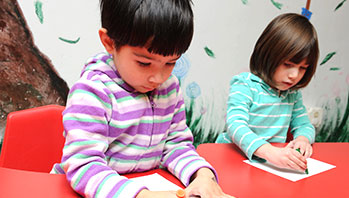- Chicks and Salsa (book)
- collection of recipes written on cards
- recipes children brought in
- plant
- recipe
MA Standards:
Literature/RL.PK.MA.9: With prompting and support, make connections between a story or poem and one’s own experiences.
Writing/W.PK.MA.2: Use a combination of dictating and drawing to explain information about a topic.
Head Start Outcomes:
Literacy Knowledge/Early Writing: Uses scribbles, shapes, pictures, and letters to represent objects, stories, experiences, or ideas.
PreK Learning Guidelines:
English Language Arts/Composition 16: Use their own words or illustrations to describe their experiences, tell imaginative stories, or communicate information about a topic of interest.
Draw and Write Together: Our Recipe Book

© Commonwealth of Massachusetts, Department of Early Education and Care (Jennifer Waddell photographer). All rights reserved.
ELA Focus Skills: Concepts of Print, Sequencing, Vocabulary, Follow Directions, Writing
Gather any recipes children have brought from home. Assure any children who didn’t bring in recipes that you have some they can use.
First, talk with children about what a recipe is. Show children the recipes at the back of Chicks and Salsa. Choose one of the recipes to read aloud. Point out that all recipes follow a similar order:
- First, there is the recipe name at the top. This helps you find the recipe.
- Next, there is a list of all the ingredients you will need.
- Last, there are steps to follow so you know exactly how to make the recipe.
Explain that you have to follow the steps in order for the recipe to come out tasting the way you want it to.
Attach each child’s recipe card to a larger piece of paper. Talk with children about which ingredients in the recipe are plants. Have children draw the plants on their paper. When everyone has finished, gather children’s cards into a book. Title the book “Our Recipe Book.”
Adaptation: In groups with varying ages, challenge older children with sequencing. Say, Many things happen in order, or sequence. Tomorrow can’t come before today. You were 3 years old after you were 2 years old. You are a baby before you are a preschool child. Have children listen to each of the lists below as you read it. Explain that the things on the lists are out of order and you want children to help you put them in the correct order. Read the following lists, one at a time, and guide children to repeat the items in proper order: 1-3-2-4; breakfast time, bedtime, school time; A-D-B-C-E.
